|
Introduction
Integral Field Spectroscopy (IFS) is the technique that allows to obtain the
spectra of a more or less continuous region of the sky. The light
coming from different positions in the sky is conducted and resampled in the
spectrographs by several different techniques (lens arrays, fiber bundles,
image slicers....). These different implementations have produced a set of
instruments, which, sharing the basics of the technique, produce very
different representations of the spectra in the detectors. These apparent
diversity leaded to the creation of reduction techniques and/or packages for
each individual instrument. Together with the inherent complexity of this
technique, this has reduced the use of IFS for decades to a hand-full of
specialists, mainly attached to an specific instrument.
IFS specialists have realized of this handicap (Walsh & Roth 2002), and
started to produce standard techniques and tools valid for any integral field
unit (IFU). In particular, the Euro3D RTN (Walsh & Roth 2002) has created a
standard data format (Kissler-Patig et al. 2004), a coding platform
(Pécontal-Rousset et al. 2004) and a visualization tool (Sánchez
2004), useful for any of the existing IFUs. All these tools are freely
distributed to the community, and can be downloaded from the Euro3D webpage and the E3D webpage. Following this
effort we have started to develop a reduction package for the reduction of any
fiber-based IFU data, and in particular PMAS data.
Coding Platform and distribution
We coded the algorithm in Perl, using the
Perl data language PDL, in order to
speed-up the algorithm testing phase. It is our intention to translate all the
algorithms to C, following the standards defined by the Euro3D RTN (see above).
However, even in this phase R3D is fast enough to produce valuable
science frames in reasonable time, and its speed is similar or even faster
than similar packages coded in IDL, like P3d.
A major advantage of using Perl is that it is a freely distributed, platform
independent, language, and therefore R3D can be installed under almost any
architecture without a major effort and not cost. The instructions of how to
download and install R3D can be found in its webpage, where we will keep updated
the different versions.
 |
Figure 1
Section of a raw frame taken with PPAK. It shows the spectra of a
continuum-lamp in the science fibers and a ThAr spectra in the calibration
ones.
|
IFS data reduction
In general terms any IFU raw frame looks quite similar. It shows
several spectra spatially distributed through the detector following a
certain pattern (Fig.1). Therefore, IFU data reduction share a
similar sequence of steps independently of the instrument. We assume
that the data has been BIAS corrected with whatever external tool, as
an starting point for the reduction. Once BIAS corrected, the data
reduction consist of: (a) identification of the positions of the
spectra in the detector at a certain spectral pixel, (b) tracing of
the peak of the spectra in the detector along the spectral pixels, (c)
extraction of each individual spectrum, (d) distortion correction of
the extracted spectra, (e) dispersion correction and (f) resampling in
the sky position. Each of these reduction steps have been treated with
a single (or a few) algorithm:
- Find the position of the spectra in the raw
frame
The location of the spectra in the central position of the CCD (or anyother
defined by the user), can be found using the peak_find.pl script(Fig.2) .
The output of this script is an ASCII file with the location of each spectra.
It requires a continuum illuminated frame (whatever its origin).
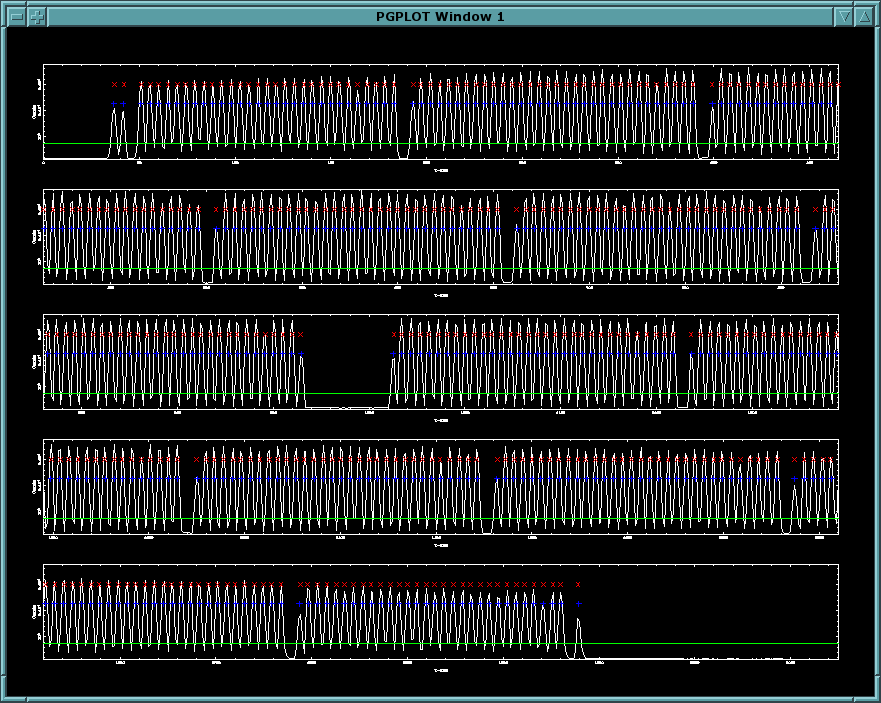 |
Figure 2
Example of the use of the peak_find.pl routine. It shows the
identification of the spectra in a PPAK raw data.
|
- Trace the position of the spectra along the spectral
direction
Once located the spectra in the central position of the CCD, it is needed to
trace this position along the spectral direction, using the
trace_peaks_recursive.pl(Fig.3). This script requests the output of the
previous one, and produce a FITS file (the trace) with the location of
the spectra for each pixel in the spectral direction. It requires a continuum
illuminated frame (like the previous one).
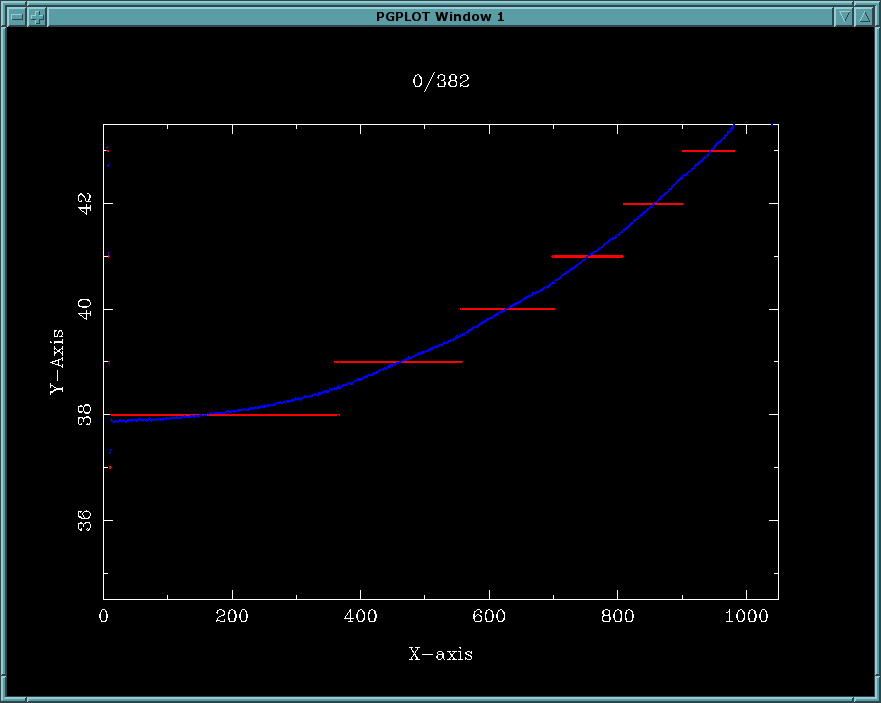 |
Figure 3
Example of the use of the trace_peaks_recursive.pl routine.
Figure shows the distortion of the spectra along the CCD a PPAK raw data
(blue line) showing the nearest pixel (red line).
|
- Extract the spectra
Once located the spectra in the CCD it is possible to extract them, using the
extract_aper.pl (for pure aperture extraction), or
extract_aper_CT.pl (for Cross-talk corrected extraction, that is very
slow)(Fig.4). It requires the trace frame, a raw-frame and the output is a
FITS file with the length of the pixels in the spectral direction and the
height the number of spectra.
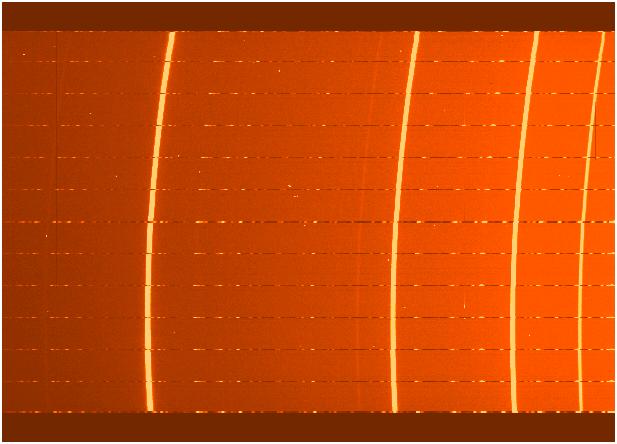 |
Figure 4
Example of the use of the extract_aper.pl routine.
Figure shows a section of an aperture extracted spectra from a comparison
ARC exposure taken with PPAK.
|
- Correct for the distortion & dispersion
The distortion and dispersion corrections are handle in R3D
separately. Using as input an ARC or an image with well defined emission lines,
we perform a 1st order distortion correction, using the
dist_cor.pl or dist_cor_cross.pl(Fig.5), identifying a single emission
line. It produces as output a 1st-order distorted corrected frame and an ASCII file with
the 1st order distortion corrections (*.dist.txt).
Once performed this correction, it is possible to correct for second
order distortion effects, using mdist_cor_sp.pl,
identify several emission lines along the spectral dispersion direction.
It produces as output a distorted corrected frame and a FITS file with the
distortion correction solution (*.dist.fits).
The distortion correction found using these scripts (*.dist.txt and *.disp.fits) can be applied to the
science data using the mdist_cor_external.pl.
The dispersion solution is found using the disp_cor.pl script,
identifying the wavelength of several emission lines interactively.
It produces as output a dispersion corrected frame and an ASCII file with
the dispersion solution, that can be applied to the science data using the
disp_cor_external.pl script.
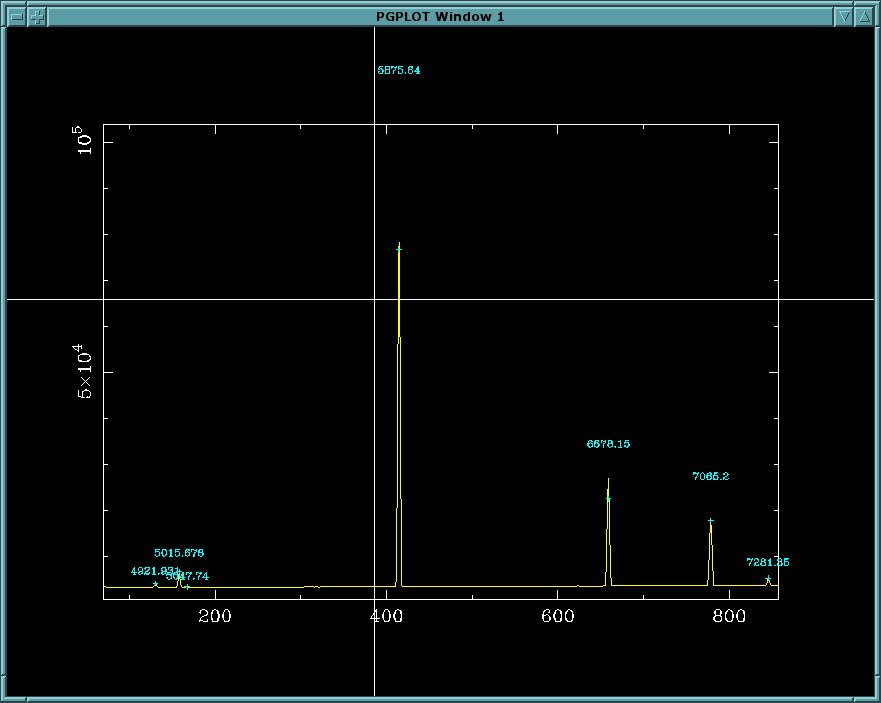 |
Figure 5
Example of the use of the disp_cor.pl routine.
Figure shows the graphical tool for interactive identification of the ARCs
emission lines.
|
- Fiber-to-fiber transmission correction
Fibers have different transmissions that may depend on the wavelength. To
determine the difference in the fiber-to-fiber transmission we use the fiber_flat.pl or
fiber_flat_trans.pl scripts. They require a continuum
illuminated frame as input frame, and produces a FITS file with the
fiber-to-fiber transmission difference.
The science frames can be corrected for this effect by dividing for this file,
using the imarith.pl script.
Science Gallery
As we quoted before, R3D has been tested over different IFUs data, proved to
be useful for reducing them in an homogeneous way. We present here a few
examples of data reduced with this tool:
| VIMOS DATA ON NGC 3242 |
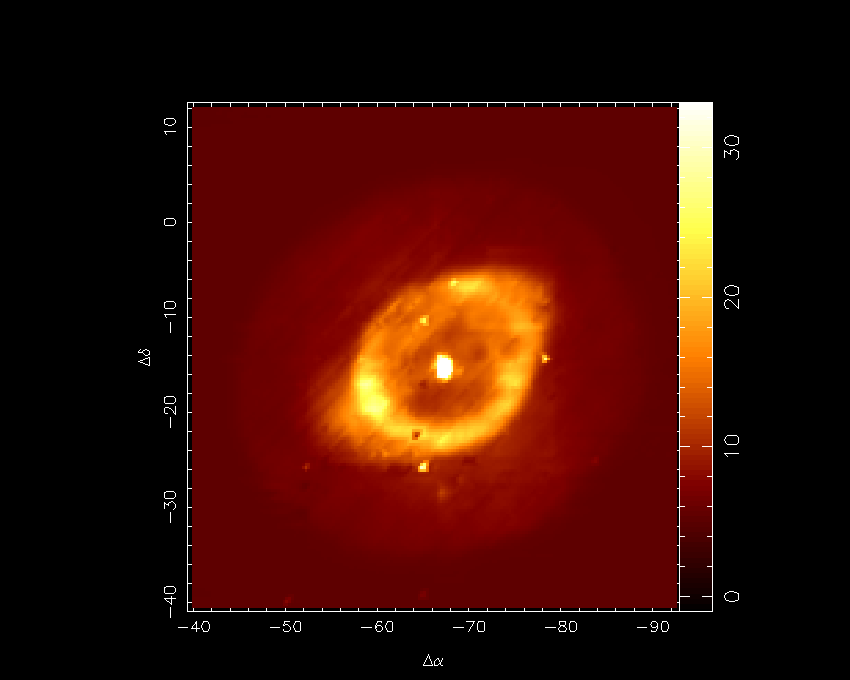 |
Figure 6
Figure shows the planetary nebulea NGC 3242 observed with VIMOS in the
Low-resolution blue mode (PIs: Schwartz & Corradi). It shows a cut centred in
[OIII]5007, using E3D.
|
|
| PMAS/Larr DATA: Bow-shock in Orion |
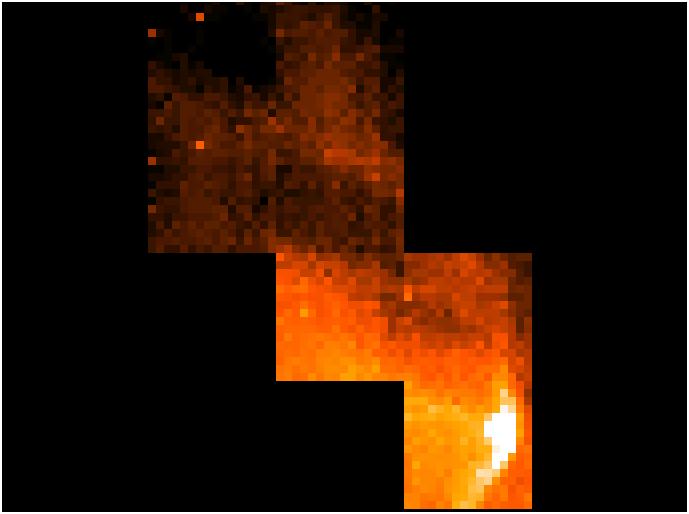 |
Figure 7
Figure shows the Halpha emission in a Bow-shock in the Orion nebulae,
observed with PMAS/Larr in the 1'' resoluton mode, performing a Mosaic.
(PI: Angels Riera)
|
|
| PMAS/PPAK DATA: Gas content in type I AGNs |
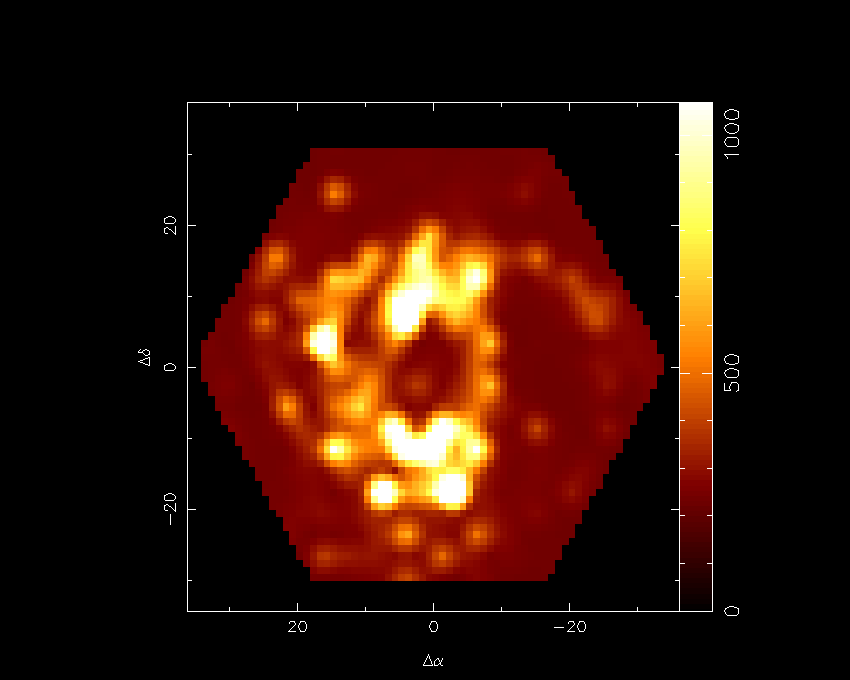 |
Figure 8
Figure shows the continuum subtracted Halpha emission of a Seyfert 1
galaxy at z~0.03 observed with PPAK, using the V300 grating, covering the
wavelegth range between 3700-7100 AA. (P.I., S.F.Sanchez)
|
|
| PMAS/PPAK DATA: Stellar Populations in type I AGNs |
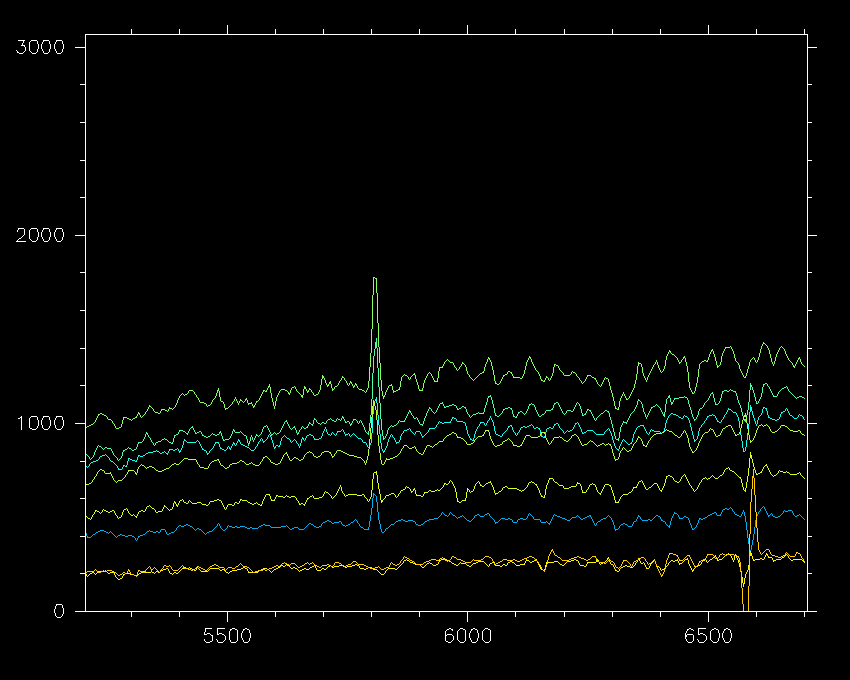 |
Figure 9
Figure shows a selected sample of spectra from the object shown in
Fig. 8. It is shown the spectral range corresponding to Hbeta and [OIII],
showing clear differences in the stellar populations in different regions.
|
|
Bibliography
- Arribas, S., Carter, D., Cavaller, L., et al., 1998, SPIE, 3355, 821
- Kelz, A., Verheijen, M., Roth, M.M., et al, 2005, PASP, submitted
- Kissler-Patig M., Copin Y., Ferruit P., 2004, AN, 159
- LeFevre, 0., Saisse, M., Mancini, D., et al., 2003, SPIE, 4841, 1670
- Pécontal-Rousset A., Copin, Y., Ferruit, P., 2004, AN, 325, 159
- Roth, M.M, Bauer, S., Dionies, F., et al., 2000, SPIE 4008, 277
- Sánchez S.F., 2004, AN, 325, 167
- Walsh, J.R., Roth, M.M., 2002, Messenger 109, 54
|









